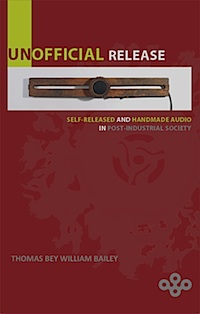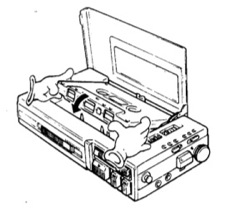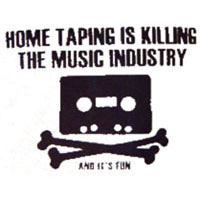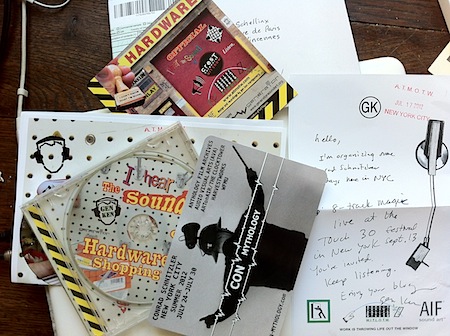![]() [Aug. 01st, 2012] A (slighty revised and a little expanded) Dutch version of this SoundBlog entry appeared on the online pop-media-culture magazine FRNKFRT.
[Aug. 01st, 2012] A (slighty revised and a little expanded) Dutch version of this SoundBlog entry appeared on the online pop-media-culture magazine FRNKFRT.
UnOfficial Release
july 26, 2012.
'Think of a semicolon as a comma with vibrato...'
Unofficial Release is the title of a recent book, in which the American (in his own words:) 'multi-disciplinary artist and cultural researcher' or 'psycho-acoustic sound artist and writer on saturation culture' Thomas Bey William Bailey reflects at length on the phenomenon of 'self-released and handmade audio in post-industrial society'.
That's a bit of a windy way to say that in his book the author sets out to track the stories of - especially - 'purist' factions within the larger domain of DIY audio-publishing, in a realm that spans a broad spectrum of (pop/rock/electronic/experimental...) music from the late 1970's onward; often (but not exclusively) in the context of (world wide, exchange) networks of collaborating and/or competing groups of artists; networks, that form the source and, to a big extent, also the works' target = audience (which, I presume, at least partly accounts for the adjective 'post-industrial' in the book's subtitle).
 Unofficial Release is a laudable enterprise. I'm quite sure that many of the SoundBlog's viewers will have their pretty good own ideas on the subject of Thomas Bey Willam's book. [ I hope I'll be forgiven, but I will just call him Thomas in what follows. ;) ]. Let me also make it clear from the beginning, that - whatever its shortcomings - this is an interesting and worthwhile book, that harbors a lot of fascinating facts and observations. Often I agree, sometimes I disagree a little, sometimes I disagree a lot; and sometimes I (think I) do not understand; which must be due to Unofficial Release's style, that looks & feels academic, but on the whole lacks the rigor and precision necessary for (academic) depth. Which, mind you, is not a problem per se: for me it made reading (and re-reading) Unofficial Release into a rather spectacular-ish roller coaster ride.
Unofficial Release is a laudable enterprise. I'm quite sure that many of the SoundBlog's viewers will have their pretty good own ideas on the subject of Thomas Bey Willam's book. [ I hope I'll be forgiven, but I will just call him Thomas in what follows. ;) ]. Let me also make it clear from the beginning, that - whatever its shortcomings - this is an interesting and worthwhile book, that harbors a lot of fascinating facts and observations. Often I agree, sometimes I disagree a little, sometimes I disagree a lot; and sometimes I (think I) do not understand; which must be due to Unofficial Release's style, that looks & feels academic, but on the whole lacks the rigor and precision necessary for (academic) depth. Which, mind you, is not a problem per se: for me it made reading (and re-reading) Unofficial Release into a rather spectacular-ish roller coaster ride.
Early on (page 16) Thomas states that by unofficial ( * ) audio he means: "audio in which every phase of the creative process, with the possible exception of creating the recording medium itself, is handled by the creators proper: with no reliance on disc duplicators, printing presses, mastering and post-production facilities, professional graphic design services and so on". That's an awkward formulation, but it does clarify that in the pages that follow, 'unofficial release' actually is meant to be synonymous with 'handmade release' of audio works: releases for which the recording of the work, the duplication of the recording and the packaging of the result, were all done by the artists themselves. (That should explain my use of the word 'purist' above.)
This drastically limits the subject: taken to the letter it will exclude pretty much all releases on vinyl and audio CD, as well as the independent releases on cassette tape (who knows how many? Thousands? Tens of thousands?) that come with printed covers and were produced with the help of a 'commercial' tape duplication service. Therefore Thomas' definition also excludes outsider musicians like Jandek (who self-released a massive oeuvre, but always on vinyl albums and later on audio CD) and other maverick geniuses/curiosities. He justifies this exclusion by pointing out that the DIY work of musicians like Jandek and his ilk have already been extensively documented elsewhere (fair enough), but also, curiously, adding that he chooses to focus on "those who have struggled to make as authentic an expressive corpus as possible without seeking [...] any form of assistance from third parties". Personally, I'd hardly consider delivering a master tape to a record pressing plant and ordering a couple of hundred copies 'seeking assistance from third parties'... In the context of the book, far more relevant seems the fact that self-releasing artists like Jandek are and remain loners, that auto-publish their work because of a deeply felt urge to be heard, but definitely not in order to get social and become part of a network of 'kindred spirits'.
[...]
For some, to me not very clear, reason, the book is divided into two parts: a Play part ('Developments and Perspectives') and a Pause part ('New Challenges'). After an introduction in which Thomas explains what motivated him to embark on the research for Unofficial Release, three of the Play part chapters are dedicated to the history and practice of mail art. I am pretty sure that in the days before the arrival of the cassette, audio did circulate within postal art networks on reel-to-reel tapes. But it was the cassette player/recorder's rise to the status of 'common household item', that made the exchange of audio by mail as easy as that of letters, cartoons or collages. Thomas interviews Andrej Tisma and Rod Summers, whose VEC audio exchange program (active between 1978 and 1983) forms a wonderful bridge between mail art and the subsequent 'audio networks', that (other than Rod's project) were far more focused on the exchange of (some form of) music. Rod, quite tellingly, says: "When home-produced music became the dominant content of the works being received for the VEC audio exchange program, I stopped the activity" (page 62).
The self-releasing art/music networks that we encounter in and between Unofficial Release's lines all have an undeniable, ex- or implicit, idealistic 'socio-political' edge: by handmaking their works, in a way such that each copy becomes a unique 'gift' that is shared through the network, and by staying far from the 'official' market controlled & exploited by the 'official' culture, the self-releaser (consciously or not) takes a political stance.
Ideally, the autonomous ( ** ) composer/musician will, as a latter-day Partch, also built his own instruments and carve his recordings in, say, clay scooped from public gardens. And though in these past four decades some may have gotten close, and several - no joking - these very days are getting even closer, this über Zen-ish ideal will/can be reached by a mere handful at most ( *** ). In almost all cases 'autonomous musicians' will have few second thoughts about their art being totally dependent on the commercially produced consumer technology that is unleashed upon them by the 'official' culture's capitalist allies. In this sense (as the author is well aware, page 79) the 'autonomous (subcultural) art networks', besides the 'self-organizing (pseudo-)anarchy', also share the intriguing (parasitical) gadfly/leech-like qualities of, for example, the very influential squatters network in the Netherlands of the late 1970's / early 1980's.
This is a paradox, faced by whatever pseudo-anarchic unofficial alternative to whatever something official in today's 'post-industrial society'.
And mostly, it's just ignored.
[...]
'Why We Tape: Cassette Culture As A Real Alternative' is one of the book's key chapters. What made the compact cassette so successful? Though (cassette) tape - like the vinyl record - by now (in our parts of the world) as a day-to-day household thing for music consumption has become obsolete, it is most certain to survive as one of several media (magnetic tape, vinyl, digital formats ...) that sound artists/music producers nowadays may choose to work with; because of their physical characteristics and specific properties; some of which are very real; others, arguably, largely imaginary. Much already has been said on magnetic tape, of which the playing and spooling, within or without the confines of a cassette, is an obvious image and metaphor for time's unwinding. Unofficial Release adds some more: anthropomorphic quality... pareidolic design... the 'tape in a box' as a metaphor for stuff inside our very selves... Thomas then turns a somewhat different corner, when (page 80) he states that it has been not so much the control over the production's medium, as the "control of the [interpersonal] distribution process that really differentiated the new Cassette Culture from other independent initiatives".
Self-releasing handmade works became viable for musicians and other audio artists, when, from the early 1970s onwards, compact cassettes and the equipment necessary for their recording and playback, gradually were getting cheap enough for all to buy; and then quickly became ubiquitous, not in the least thanks to the industry's massive promotion and advertising. It inspired an army's worth of musicians and artists (with all imaginable gradations of technical skill, ingenuity and talent) to self-release original audio works on cassette, which, indeed, was not a use for cassette tape that had been foreseen by its developers; and this in turn happened not in the least thanks to the DIY/fuck all attitude that these artists' generation adopted from the protagonists of the seventies punk-rock wave.
The cassette's ultimate moment of glory was brought about, at the dawn of the 1980's, by the 'personal stereo experience' of Sony's Walkman, a prime example of a technological innovation bringing consumers a something, of which they themselves didn't know how desperately they were in need of it.

Originally DIY releases in punk & post-punk style (many of which were handmade at least up to and inclusive their cover) appeared pretty much exclusively on vinyl. The cassette release boom came a bit later, along with a surge in (often noisy and/or electronic) musical experimentalism, for which even the smallest possible of vinyl editions (usually somewhere between 300 and 500 copies) in most cases proved to be way overestimating what the artist's share of the market (family, friends, fans & kindred spirits ...) was able and willing to handle. In other words: in view of estimations of expected sales, the choice for copying by hand of some tens of cassettes over the pressing of a couple of hundreds of vinyl platters, usually was an utterly realistic one.
[...]
Having unwound the cassette, the author immediately tackles the dawning of the digital age, in a chapter ('Laser Sharp. Self-released audio goes digital') dedicated to the CD(-R), the blinking silvery plastic support of digital audio (that for many years enabled the 'official' music industry to propel its profits to mega-heights), and its virtual follow-up, the online stored mp3's (that, sooner or later, will lead to the dismantling of that same 'official' music industry, which, in its current form, has become obsolete and cannot but cease to exist). The switch to digital was readily adopted by almost all self-releasers. Of course. For self-releasing obviously was (and still is) foremost about content (that what is being released), and only a little about the carrier of that content (the format in which it is being released). Thus pretty much all cassette labels went the way of the then still Amsterdam based Staaltape: they dropped the cassette and switched to CD(-R). Only recently there has been an interesting revival of self-release on cassette and/or vinyl (not always solely for reasons of nostalgia and exclusivity), while CD(-R) now by many is considered as being inferior from a design & 'experience' point of view. That is: not so much the sound quality is being questioned (though some do), as the object-ivity and durability of the CD(-R) as a (collectable) thing. Generally spoken, though, in the current state of affairs, any format can, and will, do; though handmade of course is an adjective that will not be easy to maintain with respect to fully digital web audio releases.
[...]
Thomas switches from the digital present back to (post-)industrial music, a genre whose bloom in the 1980's was accompanied by a world-wide avalanche of unofficial, handmade, industrial-ities: in print, on cassette & on vinyl. It is here that one encountered sounds, music, words & ideas , that because of their extreme (be it perverse, sexually deviant, dope-and crime-related, left-anarcho-terrorist or right-fascist) and (officially) offensive character, one can hardly imagine being released otherwise than through these unofficial networks.
[...]
After a foursome of informative chapters, each of which centers around a conversation with a veteran key player in the global autonomous music network - Vittore Baroni (Italy), Frans de Waard (the Netherlands), Al Margolis (USA) and GX Jupitter-Larsen (Canada) - the Pause ('New Challenges') part of the book opens with reflections on why the Mini Disc format 'failed to make an impact'. In the chapters that follow, Thomas takes us on a tour of subjects including but not limited to: 'Incorrect Music', Song Poems, Mingering Mike's imaginary records, artifical scarcity, the art of packaging and (very) limited edition unoffical releases' packaging as art, the (literal) drenching of records in artist blood and other fetishes, satanists' use of heavy & black metal music as a weapon of attack, the hyper-releasing of e.g. a Merzbow...
Reasons for self-releasing one's music vary, but the main ground (seldomly mentioned explicitly) surely remains this: it is done, because it is possible to do. That self-releasing actually might be considered an act of resistance and opposition (viz. the 'official'/major music-industry or even the 'less official' independent labels), will often be little more than an afterthought that might add (for those that are sensitive to such things) a whiff of 'street credibility' to the enterprise.  A pretty large group of (would-be) artists will consider self-releasing merely as a 'first step' in a future recording career. Other musicians and groups in the long run will release part of their work through more 'official' channels, while continuing to 'self-release' projects that are deemed too 'experimental', too 'extreme' or 'too lo-fi' for 'official' releases.
A pretty large group of (would-be) artists will consider self-releasing merely as a 'first step' in a future recording career. Other musicians and groups in the long run will release part of their work through more 'official' channels, while continuing to 'self-release' projects that are deemed too 'experimental', too 'extreme' or 'too lo-fi' for 'official' releases.
But whatever we call it, and whatever way we cut the pie: Unofficial Release puts a spotlight on what the author in the very first line of his introduction calls self-determined art. Even though self-determined as a term is even worse than unofficial, we know what he is getting at: a beast that, by its very nature, is not easy to pin down.
[...]
Nobody is in control. (The book has a somewhat curious chapter on self releasing and censorship.) There is nobody to decide what sort of stuff deserves an unofficial release, and what parts of it should be tossed even more directly into the bin. The 'chaotic, non-purposive character' (page 100) of the global autonomous audio network is both the phenomenon's force, and its weakness. It accounts for the "adventurous listenership", that attracts groups of music fans fed up with much of that what is officially released. The size of such groups will not likely ever be able to account for 'million sellers'; but it also should not be underestimated.
Much - even: most - of that which over the past decades has been unofficially released, is pure crap. Rubbish; indeed: bin-stuff. And then there's a lot that is mediocre. But you and me, of course, are into 'it' for the good stuff ;) and for the occasional works of pure genius. Where to find these, will, as always, depend on your taste; and on your willingness to dig more or less deep.
The good stuff... In this blog (which, indeed, is itself an unofficial release and a fortiori part of these very same autonomous network(s) ( **** )), I usually refer to what I consider to be the good stuff as 'non-academic experimental music' (though after having read Adam Harper's Infinite Music, another recent, interesting and equally 'chaotic' music book, I currently tend - slightly tongue-in-cheek - to replace the 'experimental' by 'post-experimental').
...
Maybe the most important conclusion / statement of the book is made in the very beginning, on page 15, where the author states that the global autonomous music network played a pivotal role in 'the survival of radical sonic eclecticism into the 21st century'.
Indeed.
It is as difficult to ignore its economic irrelevance, as it is difficult to ignore the cultural importance of this global, alternative, autonomous, underground musical scene. It is a parasite, that because of its economic irrelevance, is left to bloom freely, at a pace and in whatever way that convenes, without rules and without laws other than those implicit in its own conventions (which, admittedly, sometimes may be a pretty hard nut to crack ;) Meanwhile, though, and at no extra cost, the network continues to happily infect official art and academic institutions, in a continuous process of free exchange through a growing group of actors that choose to be active in both worlds.
A loose network of networks, that came into existence some 35 years ago, almost as a side effect; as an unmistakable by-product of the commercial development and marketing of consumer audio technology; a web-like network, really, that - exchange and copy-based - resembles an analog, bike-speed version of the digital, light-speed world wide web. No wonder, therefore, that once the digital web had become 'audio ready', most of the actors in the 'autonomous audio' network readily adapted the digital web as their new tool and homeland. At this moment in time, that network is larger and more active than it ever has (or could have) been before. It is also far more elusive than it ever was before.
...
It was an agreeable coincidence, that while writing these words & thinking about the ever-increasing dematerialization inherent in web-based networks, I found a package in my snail mail box from Ken Montgomery, a mail art, cassette culture and autonomous audio network veteran based in New York. It made me realize how good it feels to, every now and then, find some news & sounds that one can actually touch ... Like the invitation to join in Con-Mythology, a series of events in NY, between July 24th and 30th, celebrating the music and art of last year deceased Conrad Schnitzler, who (as we read in Unofficial Release, page 159) "despite his pedigree and potential for exploiting [his] 'star connections', [always] has remained one of the most steadfast proselytizers of hand-made music". Or like GenKen's lovely and very colorful (artist throwing money out of the window) I hear the Sound of Hardware Shopping CD-R, the title of which is a pretty complete summary of the disc's sonic content, except that these words alone miss out on the real fun. And on the pig and the parrot :)
...

...
Thomas did not want to write a complete book. And so, no, Unofficial Release is not complete. It is also far from an easy introduction to the subject, and probably best accessible (and most enjoyable) for those that already have some knowledge about e.g. cassette culture. Large parts of it read like collected notes on the (many) themes that the book touches upon; most of these themes might (and, thinks I, eventually should) be developed, into what each could be a book (or thesis) all by itself: questions of censorship and self-censorship in autonomous audio, and its role in the former communist parts of Europe; the emergence and development of audio networks on the web, and how these relate to their 'snail mail' ancestors; history & sociography of e.g. (post-)industrial music or satanist black metal, as genres that would have been pretty much unthinkable without these global & underground 'autonomous music' network; etc., etc. ... Enough material here for many now & coming generations of graduate students to write and write and write their papers on :-) ...
[ Thomas Bey Willam Bailey. Unofficial Release. Self-released and handmade audio in post-industrial society. Belsona Books, 2012. ISBN 9780615611273. 382 pp. ]
 |
 |  |
notes __ ::
(*) I find the term unofficial an unfortunate choice. Quite obviously it is meant to refer to artistic work that, in one way or other, is done outside of the official art/music circuit. The problem of course is, that what in this area official means, is far from fixed and clear-cut. There is a vast 'terrain vague' between the institutions, contexts and events that are obviously official, and those that are obviously unofficial. A major deal of the most interesting 'unofficial' art/music indeed can be thought of as living in this 'cultural wasteland'. [
^ ]
(**) When writing on the subject, 'autonomous' is the term that I prefer. [
^ ]
(***) OK. True. I will have to think deeply about naming a concrete example of such an 'autonomous-to-the-extreme' artist, and I don't have one ready just yet. But I'm sure I'll be able to find you at least one... [
^ ]
(****) From that point of view an interesting detail is, that - as far as digital publications go - the SoundBlog is probably as close to 'handmade' as one can possibly get. This blog does not use any third party software for its creation, nor for its maintenance. All entries are - and are bound to remain - hand coded. [
^ ]
tags: mail art, cassette culture, autonomous audio
# .427.
Read all about Found Tapes, Foundtaping and Audio Cassettes (K7s) on the SoundBlog:
(2023, september 21) - Holland[s] Spoor
(2022, january 11) - 'The Art of K7', vol. 1
(2021, september 11) - The Art of K7 :: Sudokaising [ii] Time Folds
(2020, march 21) - The Art of K7 :: Sudokaising [i]
(2019, november 17) - Foundtapers & Foundtaping in Porto
(2019, februay 08) - CCNL :: Cassette Culture in Linz, Austria
[ii] The aesthetics of erasure
(2019, januay 18) - CCNL :: Cassette Culture in Linz, Austria
[i] Oral history
(2015, november 22) - Situasonnisme: the City Sonic Festival
(2014, june 19) - Lecture de Cassette
(2013, october 25) - The Art of K7 (prelude) [sketch/book, 1]
(2013, march 23) - "Ma première cassette était vierge..." Mourning & celebrating 50 years of compact cassette
(2012, july 26) - UnOfficial Release
(2010, november 28) - Foundtaping, Maps & Shadows
at the Basel Shift Festival (i.)
(2009, november 15) - prof. dr. Cassette
(2009, november 08) - A found tapes meta-map
(2009, october 22) - Founded Tapapes
(2009, september 20) - Found Lost Sound
(2009, july 26) - "You, a bed, the sea ..." [ 1. Athens, sept. 28th 1994 ]
(2009, may 23) - It feels like summer in the city [KT2009, i]
(2009, february 19) - Time and the weather - "? Footage or Fetish" @ Käämer 12, Brussels (ii)
(2009, january 30) - A Tingel Tangle Tape Machine - "? Footage or Fetish" @ Käämer 12, Brussels (i)
(2009, january 15) - Kassettenkopf
(2008, december 08) - un-Tuned City (foundtaping in Neukölln)
(2008, september 14) - Psycho/Geo/Conflux in Brooklyn, NY __i.
(2008, august 31) - " Le chasseur " (foundtaping in brussels_ii)
(2008, june 18) - "Sing Laping, Sing !" (foundtaping in brussels_ i)
(2008, january 06) - Mo' Better Mo-Tapemosphere, 2. Restmuell
(2007, june 16) - Mo' Better Mo-Tapemosphere, 1. "chase away all my fear"
(2007, march 07) - Back to Berlin 2. Found Tapes
(2006, september 28) - jenny likes poets
(2006, september 06) - the sound of almost-no-more words
(2006, june 13) - fotex #49-51
(2006, june 04) - Sonofakunsttoer
(2006, april 17-25) - 'sudoku-solution' in 'de nor'
(2006, january 19) - ride, buggy, ride ... !
(2006, january 13) - axiologie for dummies
(2005, november 06) - found in maastricht
(2005, august 28) - tête-de-tettine / tête-de-cassette
(2005, august 23) - tape busters and coordinates
(2005, july 02) - Conquering America ...
(2005, june 03) - stationed soother
(2005, april 21) - Low-fi : the new Readymades
(2005, march 24) - d_Revolution #1 ...
(2005, february 07) - found tapes for spies
(2005, january 28) - "parfois l'amour tourne à l'obsession ..."
(2004, november 06) - à la tranquilité
(2004, july 20) - instructions in arabic
(2004, may 08) - phound stufphs
(2003, august 04) - new acquisitions #7, #8
(2003, may 04) - r2r
(2003, april 24) - splice and tape
(2003, april 15) - new acquisitions #5,#6
(2003, january 09) - finders keepers
(2002, november 24) - exhibit #4
(2002, november 08) - what fascinates me
(2002, november 07) - more on found tape montage
(2002, september 14) - detour
(2002, september 09) - 2 down, 3 to go
(2002, september 06) - magnetic migration
Read about Found Tapes in Gonzo (Circus) [Dutch]:
Gonzo #163, mei/juni 2021 - Lang Leve Lou Ottens
Gonzo #137, januari/februari 2017 - Het Kaf en het Koren
comments for UnOfficial Release ::
|
Comments are disabled |